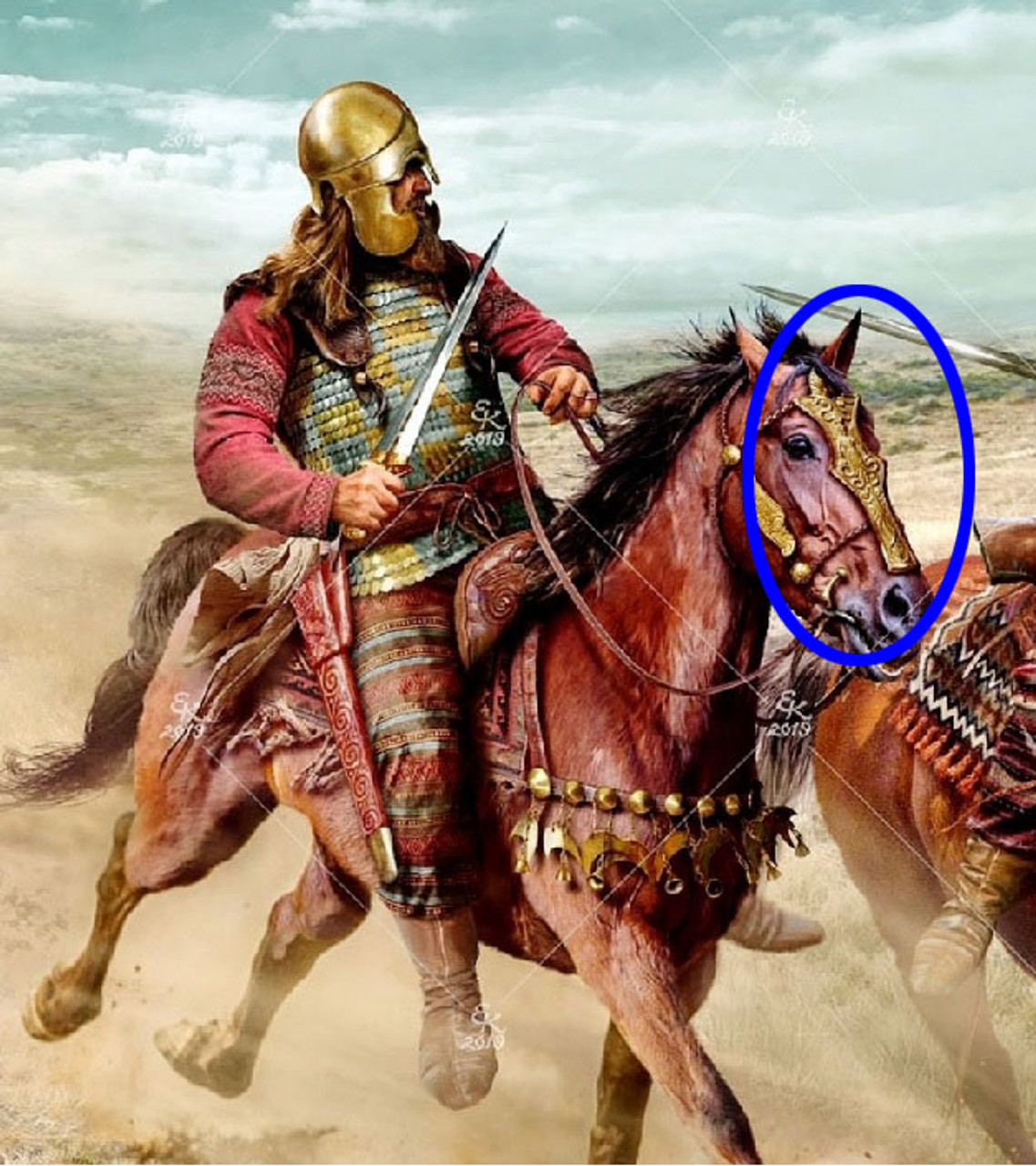Product Description
SEE MORE ANCIENT NEAR EASTERN ARTIFACTS
SEE MORE ANCIENT SCYTHIAN ARTIFACTS
Ancient militaria from the Eastern Saka Scythians is extremely rare and their scarcity in any collection, private or institutional, proves that. The hallmark of the Scythians was their love, dependence and glorious decorations in battle on their horses. Very few ancient cultures can come close to the elaborate dress of their warriors and war horses. Numerous excavations and recreations show light armor on their horses and in some cases, chanfrons or horse head armor.
The danger of the Scythian cavalry was their speed and agility so weighing the horses down with heavy armor was impractical. The most vulnerable part of the horse was the head as this was the first part most exposed in an attack. Horse armor for the head would have been made up of heavy leather and cloth padding and sometimes, armor plate insert as this rare specimen is. This iron horse head armor insert would have been inside a larger leather padded chanfron as seen in the above images of recreated mounts based on excavations. The cut outs above the middle would have been for the recessed part for the horse's eyes. The flared top was to protect the upper skull and the heavy plate on the lower pointed region would have followed down the nose. There is a slight curvature to this armor plate to better conform to the horse head. The circular impression in the center would have been to secure this internal armor plate the the outer layers of padding and leather by means of a rondell affixed to this point.
In over 30 years of our experience handling ancient militaria from around the world, there have only been a couple times we have come across ANCIENT horse armor, not medieval which is far more prevalent. Since this time is so early in mounted warfare, the heavy armor that later medieval cavalry would wear had not been developed nor was needed at this time. Other than small fragments of scale armor, this would be the largest form of horse armor one could positively identify from such an early time in mounted combat. It is rare beyond measure and the ultimate horse armor specimen from one of the greatest mounted armies of the ancient world!
This artifact has been professionally cleaned and conserved in our lab, being treated with a special sealer developed and formulated by us specifically for ancient metal preservation.
HISTORY
The Saka were a group of nomadic Iranian peoples who historically inhabited the northern and eastern Eurasian Steppe and the Tarim Basin. Though closely related, the Sakas different from the Scythians of the Pontic Steppe and the Massagetae of the Aral Sea region, though they all form part of the wider Scythian cultures. Like the Scythians, the Sakas were ultimately derived from the earlier Andronovo culture. The Sakas were a group of Iranic peoples who spoke a language belonging to the Iranian branch of the Indo-European languages. The Saka were racially Europoid.
Historical records and scientific studies date the Saka as early as the 8th century BC. In the Achaemenid-era,ancient Persian inscriptions found at Persepolis, dated to the reign of Darius I (r. 522-486 BC), record the Saka as having lived just beyond the borders of Sogdia. An inscription dated to the reign of Xerxes I (r. 486-465 BC) has them associated with the Dahae people of Central Asia.
In the 2nd century BC, many Sakas were driven by the Yuezhi from the steppe into Sogdia and Bactria and then to the northwest of the Indian subcontinent, where they were known as the Indo-Scythians. Other Sakas invaded the Parthian Empire, eventually settling in Sistan, while others may have migrated to the Dian Kingdom in Yunnan, China. In the Tarim Basin and Taklamakan Desert region of Northwest China, they settled in Khotan, Yarkand, Kashgar and other places, which were at various times vassals to greater powers, such as Han China and Tang China.
The art of the Saka was of a similar styles as other Iranian peoples of the steppes, which is referred to collectively as Scythian art. Ancient influences from Central Asia became identifiable in China following contacts of metropolitan China with nomadic western and northwestern border territories from the 8th century BC. The Chinese adopted the Scythian-style animal art of the steppes (descriptions of animals locked in combat), particularly the rectangular belt-plaques made of gold or bronze, and created their own versions in jade and steatite.
Following their expulsion by the Yuezhi, some Saka may also have migrated to the area of Yunnan in southern China. Saka warriors could also have served as mercenaries for the various kingdoms of ancient China. Excavations of the prehistoric art of the Dian civilisation of Yunnan have revealed hunting scenes of Caucasoid horsemen in Central Asian clothing.
 US DOLLAR
US DOLLAR
 EURO
EURO
 AUSTRALIAN DOLLAR
AUSTRALIAN DOLLAR
 CANADIAN DOLLAR
CANADIAN DOLLAR
 POUND STERLING
POUND STERLING




















